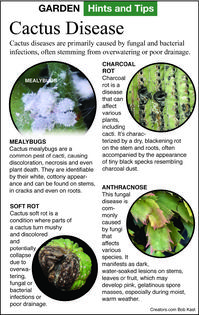The Greener View: Cactus Diseases
Q: Last year, the cactus plants in our neighbor's yard developed a disease where white stuff that looked like snow was coming out of the spine pores, and the main branches were turning yellow. Now, one of our main focal point cactus plants is beginning to look like it has the same disease. What do we do?
A: Cacti get many of the same insects and diseases that other plants get. Unfortunately, there is often not much you can do for chemical treatment of diseases on cacti because cacti hide their problems. They don't have leaves that wilt or turn yellow, and the stems often remain rigid until the very end instead of wilting and hanging down like other plants. So, by the time you notice the disease, the whole plant is infected.
White stuff that looks like snow on a cactus is a good description of the insect mealybug. They are soft-bodied with a white, waxy, fluffy coating that protects them from the sun and predators. Mealybugs are much easier to treat than diseases. Many insecticidal soap products will treat them. In some cases, they can be washed off with a garden hose. Don't spray too hard, as that can damage the cactus.
Cacti can get diseases when they are underwatered or overwatered, so do not overwater potted cactus plants or let the pots sit in saucers of water. Wet roots can allow the cotton root rot fungus to invade the plant. Sometimes this fungus attacks the roots and there are no above-ground symptoms until the plant is almost dead. Distorted stem shapes and changes in stem color should be investigated as soon as you notice these symptoms.
Several species of cacti get the fungal disease anthracnose. It causes a light brown area to get soft and moist. Then the area develops pink pustules. If only a small area is infected, cut it off and destroy it. Whole plants can become infected quickly and should be destroyed. There is no chemical cure.
Stem rot is also caused by a fungus, and it can kill the whole plant in just a few days because the symptoms do not show up until the end. It shrivels the cactus up into a mummy that is covered with brown spore pustules. If the cactus is left in place, it can infect many others. Remove the whole plant as soon as it begins to shrivel up so it cannot infect other plants.
Charcoal rot is a fungal disease of prickly pear cacti that leaves a bunch of fruiting pustules that look like bumps of charcoal on the plant. The only method of control is to remove the plants.
Not every cactus disease is caused by a fungus. A bacterium causes a disease called soft rot. It is more common when the humidity is high. It enters through wounds or natural pore openings and can spread rapidly. Infected tissue turns black and deteriorates quickly.
Cactus disease control is pretty much the same no matter what the disease is: If small areas or a few pads are infected, cut them out. If the whole plant is infected, remove the whole plant.
========
Email questions to Jeff Rugg at info@greenerview.com. To find out more about Jeff Rugg and read features by other Creators Syndicate writers and cartoonists, visit the Creators Syndicate website at www.creators.com.
Copyright 2025 Jeff Rugg. Distributed By Creators.








Comments